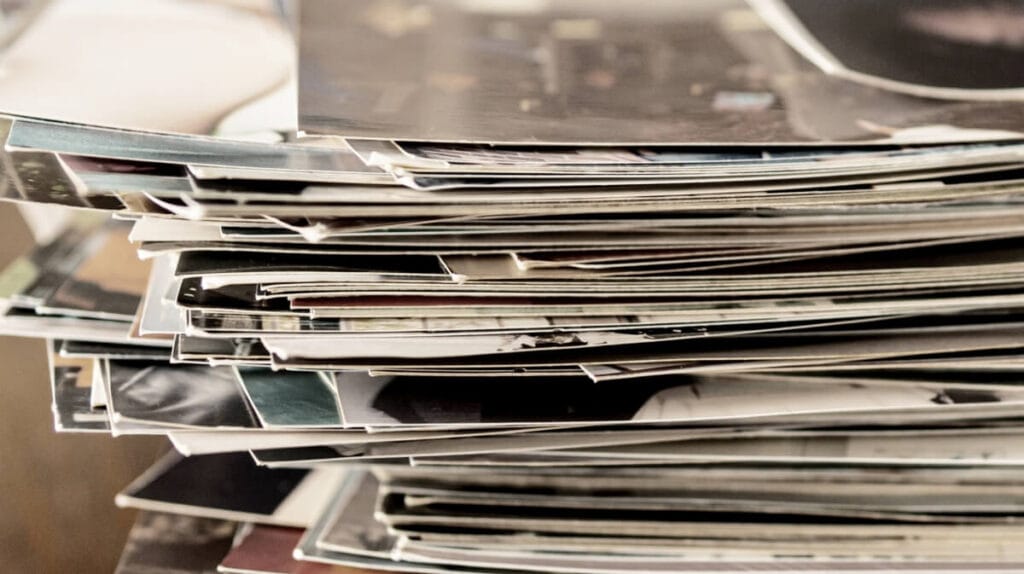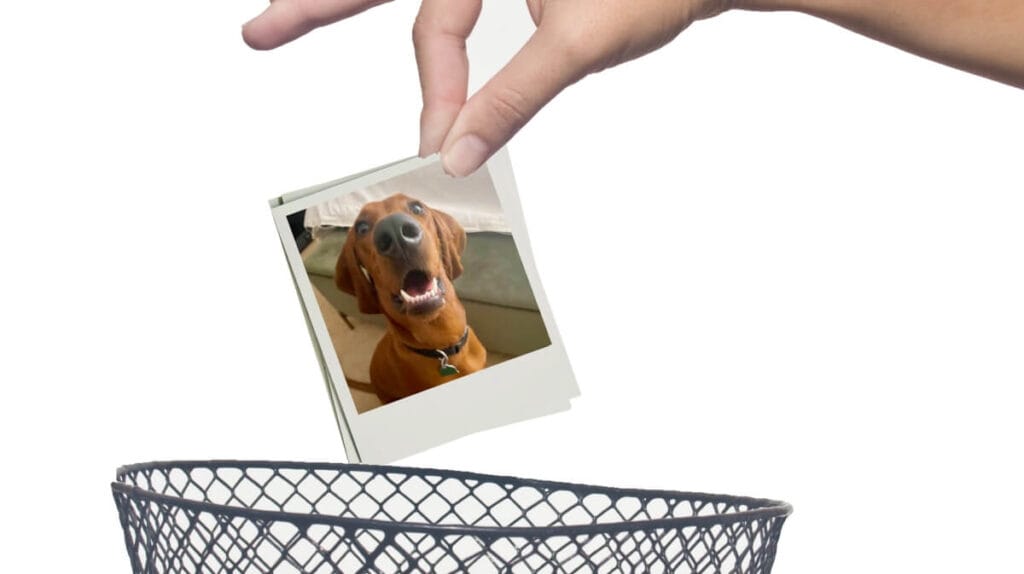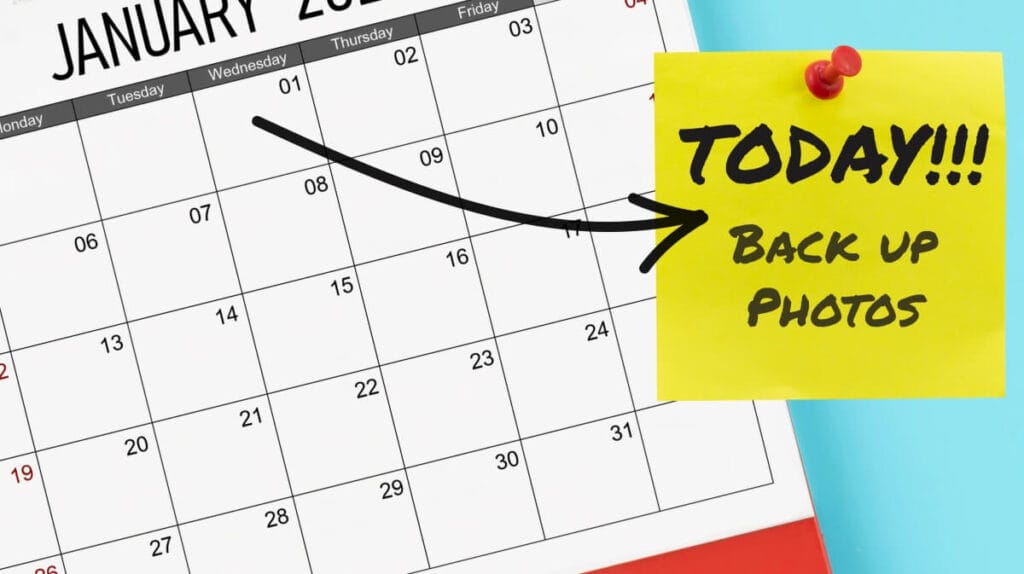5 Reasons Your Photo Collection is a Mess
(and how to fix it)

Have you ever tried to find a specific photo and given up? You’re not alone. After scrolling through thousands of unorganized files—most people call it quits. That’s because most people’s photo collections are a complete mess.
Usually, that dumpster fire of memories boils down to a few issues. These issues include cluttered phone galleries, shoeboxes full of prints, or folders labeled “IMG_4837.”
But why does this happen? More importantly, how can you not only fix it – but prevent it from happening again?
Reasons your photo collection is a disaster
01.
You Have Too Many Photos

Since most people carry around a smartphone, taking photos has never been easier. Perhaps it’s too easy. The fact that your smartphones lets you take an almost infinite amount of pictures is one of the main reasons your photo collection is a mess.
Once upon a time, when we had to get drive to a second location to get film developed, we were more selective about the pictures we took. Back then, you would never take 14 pictures of chair you sort of like at a yard sale to send to your spouse.
With smartphones, we end up with dozens (if not hundreds) of near-identical images. Every burst shot, blurry attempt, and accidental screenshot adds to the clutter.
Chaos in the form of duplicates
You’ve backed up your photos multiple times—great! Redundancy is a key component of the 321 back-up strategy after all.
But without a system to your backups, you now have the same pictures in five different locations with five different names!
Maybe you’ve transferred images from an old phone, copied files between computers, or saved pictures from social media. Without a proper system, duplicates pile up. More duplicates mean more files to search through. It also means less storage on your computer.
You don’t have a system for organization your collection
Without a clear system of organization that includes a simple-yet-consistent naming structure, finding a specific photo is like searching for a specific matching baby sock in a pile of clothes. Consider the following:
Your physical photos are unlabeled
Having unlabeled photos is apart of your organizational system – but the importance of labeling needs to be repeated. A lifetime of family history could be lost because no one took the time to write down a name and the year the photos were taken.
Imagine it’s the future and your great-great granddaughter is flipping through a photo albums.
“Who’s this?” she says, pointing at a picture of you on your wedding day.
“No clue. Keep flipping,” replies your great-granddaughter.
If no one ever labels your photos, future generations won’t know who’s in them or why they were taken.
You keep putting it off
Let’s be honest—organizing photos sounds like a tedious project. You know you should do it, but there’s always something more urgent (or more fun) to do.
The problem? The longer you wait, the bigger the mess gets. As your photos sit in storage, the more susceptible they are to fading, yellowing, and warping.
Read more: How Environmental Factors are Damaging Your Photos
How to Fix Your Photo Collection (Without Losing Your Mind)
Step 1:
Gather everything in one place
Start by pulling together all your photos. ALL of them – both digital or physical.
For Digital Photos:
For Physical Photos:
Create a central location to sort everything. For digital files, create a single folder on your main computer and rename it “Photo Hub.” For physical photos, you will need a dedicated workspace. Ideally, this will be table that isn’t regularly used. You don’t want to spill gravy on your wedding photos.
Step 2:
Purge the Unnecessary

Be ruthless. Delete or set aside blurry, overexposed, or accidental shots. Get rid of all but the best version of near-duplicate images. With your digital images, get rid of screenshots, memes, lists, and any other “reminder” photos. The goal is to reduce clutter, so you’re left with the best, most meaningful images.
This isn’t Tinder and you shouldn’t have to keep swiping right to find what you’re looking for.
For more examples of the types of images you should immediately toss, read this next.
Step 3:
Organize by Date and Event
For digital photos, create a consistent naming convention. It should include the date and a brief description. A good format is: YYYY-MM-DD_EventName (e.g., 2023-07-04_FamilyBBQ).
This makes it easy to sort and find photos chronologically. Additionally, create folders to organize your photos by year or major event.
For your printed photos, the process is similar. Sort the physical photos in chronological order or by family groups. As you organize, be sure to label each photo with the captured date and the names of the people in the image.
Here are some other tips:
Labeling is critical for establishing a clear, consistent system. This will make it much simpler to maintain your collection as well as locate specific images.
Step 4:
Digitize and Protect Your Collection
Scan important physical photos so they’re preserved as a digital file. Save the digital file on a device that is NOT your main computer. Computers break down all the time and for no apparent reason.
Therefore, use cloud backup services such as Google Photos, iCloud, OneDrive so you can pull up your images on any device with an internet connection. If you are like many people and don’t trust or like cloud services, use an external hard drive or flash drive for a physical backup.
Remember to always make multiple copies. Have at least one of the copies stored in a different location—never keep all your photos in the same place!
Step 5:
Make Maintenance a Habit

Unless you completely quit taking pictures, photo organization isn’t a one-time project—it’s an ongoing process. Here are a few easy steps to take once your collection is in order to keep it organized:
Putting it all together
A messy photo collection can feel like an impossible task, but it doesn’t have to stay that way. With consistent effort, you can transform a chaotic mix of images into an easy-to-navigate collection.
The key is establishing a clear system – one that works for your specific needs and habits. That could mean meticulously sorting every photo by date, time, and event. Or, it could mean deleting duplicates, lists and reminders, and photos of the inside of your pocket.
No matter how detailed you want your collection to be, taking the time to get your photos in order will pay off. Imagine being able to find that perfect shot to share with family and friends.
Of course, we all have limited time and energy. There’s a simple solution:
Outsource the work to a professional photo organizer. They will help reclaim your collection without the hassle and frustration. Image Archive Pro specializes in sorting, digitizing, and restoring photo collections. I’ll help you get your photos organized – before they become a part of family history that no one remembers. Contact us today to learn more about our personalized photo organization services.
Schedule a Discovery Call
Click the link below and pick a time that’s convenient. During the call, we’ll discuss the goals you have for your project and the many ways I can assist.
Fill out the Contact Form
Head on over to the Contact Page and fill out a short form.
